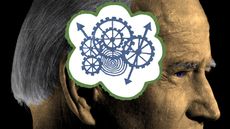How Bernie Sanders revolutionized the Democratic Party's economic policy
You say you want a revolution?


The Democratic National Convention kicks off in Philadelphia today, with one of the primetime speaking slots going to self-declared democratic socialist Sen. Bernie Sanders (I-Vt.), who fought a grueling campaign against Hillary Clinton for the Democratic nomination.
Partially, Sanders' speech represents the (tepid and strained) new rapport between the erstwhile opponents: Sanders endorsed Clinton earlier this month, and the not-so-subtle theme for tonight's presentations is "United Together."
But it's also a testament to the clout that Sanders and the wave of voters he inspired have accumulated within the Democratic Party. And nowhere is that clout more evident than in the party's platform. While it might be a stretch to call it "the most progressive platform in the history of the Democratic Party,” as Sanders himself did, it's nonetheless a sharply ambitious leftward turn following years of centrist drift — in particular on those economic issues near and dear to Sanders' heart.
Subscribe to The Week
Escape your echo chamber. Get the facts behind the news, plus analysis from multiple perspectives.

Sign up for The Week's Free Newsletters
From our morning news briefing to a weekly Good News Newsletter, get the best of The Week delivered directly to your inbox.
From our morning news briefing to a weekly Good News Newsletter, get the best of The Week delivered directly to your inbox.
There's an explicit commitment to a national $15 an hour minimum wage, indexed to automatically rise over time — a subject Clinton herself was once skittish on — as well as a commitment to end the sub-minimum wages paid to tipped workers and people with disabilities. Clinton also recently moved closer to Sanders on lowering college tuition costs and allowing college students to graduate debt-free. As such, the platform declares "every student should be able to go to college debt-free, and working families should not have to pay any tuition to go to public colleges and universities." There are pledges to not merely preserve and protect Social Security's current benefits, but to expand them; to undertake the potentially transformative goal of providing poor Americans a sort of public option for basic banking services through the Postal Service; and to move away from the narrow post-Reagan interpretations of antitrust law, and back towards the broader aim to "prevent excessively consolidated economic and political power."
There were a few losses for Sanders, too. "Medicare for all" didn't make it into the platform. Nor did a publicly financed election system or explicit opposition to the sweeping Trans-Pacific Partnership (TPP). But even in these cases, the defeats were only partial: The platform calls for allowing Americans age 55 and up to opt in to Medicare, and for a public option for health insurance; it reasserts the party's opposition to the Citizens United decision; and lays out a stringent list of requirements the TPP or any trade deal must meet to be worthy of Democratic support.
Warren Gunnels, Sanders' policy director, said the campaign got "at least 80 percent" of what it was after.
But perhaps the most striking victories occurred where Sanders' cause got considerable outside help.
On the question of reforming the Federal Reserve, the Democratic platform calls for the Fed officials who decide monetary policy to better reflect the country's diversity, and insists that "executives of financial institutions" should not serve on the Fed's governing boards. The platform also pledges the party to creating "a full-employment economy, where everyone has a job that pays enough to raise a family and live in dignity with a sense of purpose" — language that has not appeared in the Democratic platform since 1988.
Rep. John Conyers (D-Mich.), who helped found the House's 32-member Full Employment Caucus in 2014, told The Week that these parts of the platform were the result of a full-court press by members of the caucus and several activist organizations and think tanks. There was the Fed Up campaign, and a signature-gathering effort by the Economic Policy Institute. Then there was a letter from Conyers and Sen. Elizabeth Warren (D-Mass.) highlighting the lack of diversity on the Fed and insisting on reforms, which was signed by 125 congressmen and endorsed by Clinton herself. On the question of the full employment commitment specifically, Conyers said his staff "received very positive responses from top Clinton advisers."
Meanwhile, the Roosevelt Institute, a left-leaning think tank, has been running an inside-game effort to encourage a radical rethink of market policy, which seems to be influencing the Clinton campaign's thinking.
This is precisely the sort of effective activist campaign that progressives and leftists will need to keep the pressure on the Democratic Party to live up to these progressive economic goals. And it is Bernie Sanders — with his newfound political prestige, his movement network, and his remarkable fundraising apparatus — best positioned to fund and encourage them.
It's always an open question how much the party platforms matter. If Sanders wants to make sure this platform is more than just words, these are exactly the kind of efforts he should push. He's already got some real victories under his belt. The real question now is whether he can deliver more.
Create an account with the same email registered to your subscription to unlock access.
Sign up for Today's Best Articles in your inbox
A free daily email with the biggest news stories of the day – and the best features from TheWeek.com
Jeff Spross was the economics and business correspondent at TheWeek.com. He was previously a reporter at ThinkProgress.
-
 'Make legal immigration a more plausible option'
'Make legal immigration a more plausible option'Instant Opinion Opinion, comment and editorials of the day
By Harold Maass, The Week US Published
-
 LA-to-Las Vegas high-speed rail line breaks ground
LA-to-Las Vegas high-speed rail line breaks groundSpeed Read The railway will be ready as soon as 2028
By Peter Weber, The Week US Published
-
 Israel's military intelligence chief resigns
Israel's military intelligence chief resignsSpeed Read Maj. Gen. Aharon Haliva is the first leader to quit for failing to prevent the Hamas attack in October
By Justin Klawans, The Week US Published
-
 Arizona court reinstates 1864 abortion ban
Arizona court reinstates 1864 abortion banSpeed Read The law makes all abortions illegal in the state except to save the mother's life
By Rafi Schwartz, The Week US Published
-
 Trump, billions richer, is selling Bibles
Trump, billions richer, is selling BiblesSpeed Read The former president is hawking a $60 "God Bless the USA Bible"
By Peter Weber, The Week US Published
-
 The debate about Biden's age and mental fitness
The debate about Biden's age and mental fitnessIn Depth Some critics argue Biden is too old to run again. Does the argument have merit?
By Grayson Quay Published
-
 How would a second Trump presidency affect Britain?
How would a second Trump presidency affect Britain?Today's Big Question Re-election of Republican frontrunner could threaten UK security, warns former head of secret service
By Harriet Marsden, The Week UK Published
-
 'Rwanda plan is less a deterrent and more a bluff'
'Rwanda plan is less a deterrent and more a bluff'Instant Opinion Opinion, comment and editorials of the day
By The Week UK Published
-
 Henry Kissinger dies aged 100: a complicated legacy?
Henry Kissinger dies aged 100: a complicated legacy?Talking Point Top US diplomat and Nobel Peace Prize winner remembered as both foreign policy genius and war criminal
By Harriet Marsden, The Week UK Last updated
-
 Trump’s rhetoric: a shift to 'straight-up Nazi talk'
Trump’s rhetoric: a shift to 'straight-up Nazi talk'Why everyone's talking about Would-be president's sinister language is backed by an incendiary policy agenda, say commentators
By The Week UK Published
-
 More covfefe: is the world ready for a second Donald Trump presidency?
More covfefe: is the world ready for a second Donald Trump presidency?Today's Big Question Republican's re-election would be a 'nightmare' scenario for Europe, Ukraine and the West
By Sorcha Bradley, The Week UK Published